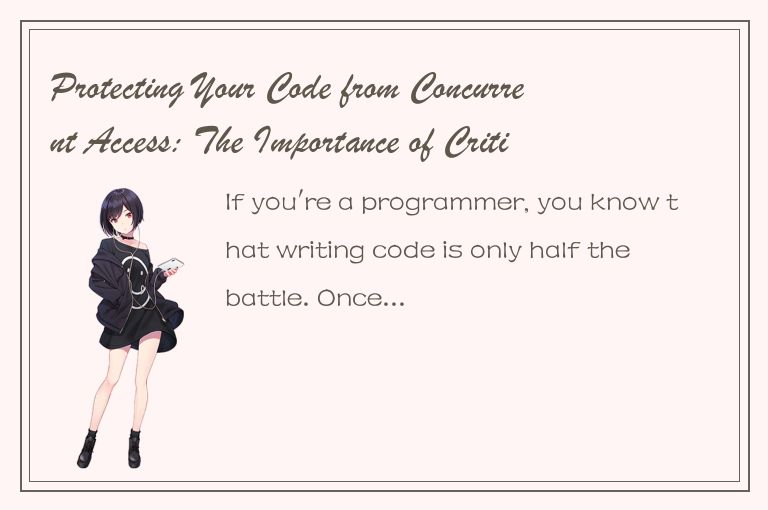If you're a programmer, you know that writing code is only half the battle. Once your code is up and running, you need to make sure that it runs smoothly and efficiently, and that it doesn't crash or create errors. One of the biggest challenges developers face is protecting their code from concurrent access. In this article, we'll explore what concurrent access is, the problems it can cause, and why critical sections are essential for protecting your code.

What is Concurrent Access?
Concurrent access happens when multiple threads or processes access the same resource at the same time. For example, if you have two threads accessing the same database, they might try to modify the same data simultaneously. This can cause problems like race conditions, deadlocks, or data corruption.
Race conditions occur when two threads try to access and modify the same data, and the order of execution is not guaranteed. For example, if two threads both try to access the same variable, one might read the variable before the other has a chance to write to it, leading to unexpected results.
Deadlocks occur when two or more threads are blocked, waiting for each other to release a lock or complete a task. This can happen when one thread is holding onto a resource that another thread needs to access but can't because the first thread hasn't released it. If neither thread releases the resource, the program can become stuck in an infinite loop.
Data corruption happens when multiple threads try to modify the same data simultaneously. For example, if two threads try to increment the same variable, they might both read the same value, increment it, and write it back, resulting in a loss of data.
Why are Critical Sections Important?
Critical sections are a powerful tool for protecting your code from concurrent access. A critical section is a part of your code that can only be executed by a single thread at a time. When a thread enters a critical section, it acquires a lock that prevents other threads from entering the critical section. Once the thread exits the critical section, it releases the lock, allowing other threads to enter.
By using critical sections, you can ensure that your code is always accessed in a safe and predictable manner. Critical sections are especially useful when dealing with shared resources like databases, files, or network connections. By limiting access to these resources to a single thread at a time, you can prevent race conditions, deadlocks, and data corruption.
Implementing Critical Sections
Implementing critical sections is relatively easy, but it requires some careful planning. Here are the steps you'll need to follow:
1. Identify the critical section: Determine which parts of your code need to be protected from concurrent access. This might include functions that modify shared data or functions that rely on shared resources like databases or network connections.
2. Acquire the lock: Before entering the critical section, you'll need to acquire a lock. This can be done using a mutex (short for mutual exclusion), a semaphore, or other locking mechanisms provided by your operating system or programming language.
3. Execute the code: Once you've acquired the lock, you can execute the code inside the critical section. Only one thread at a time can be inside the critical section, so you don't need to worry about concurrent access.
4. Release the lock: Once your thread has finished executing the critical section, it's essential to release the lock. This allows other threads to enter the critical section and modify the same data.
5. Handle exceptions: It's essential to handle exceptions inside the critical section carefully. If an exception occurs while a thread is holding a lock, it might prevent other threads from accessing the critical section, leading to deadlocks or other problems.
Conclusion
Protecting your code from concurrent access is a critical aspect of programming. Concurrent access can cause all sorts of problems, including race conditions, deadlocks, and data corruption. By using critical sections, you can ensure that your code is always executed in a safe and predictable manner. Implementing critical sections requires some careful planning and attention to detail, but it's well worth the effort in the long run. So the next time you're writing code, don't forget to think about concurrent access and how to protect your program from it.




 QQ客服专员
QQ客服专员 电话客服专员
电话客服专员